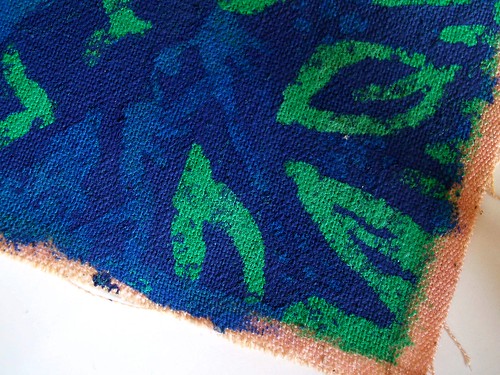 When Pietro gave me my birthday gift (a lot of colors for fabrics) I started to plan some projects to experiment with.
When Pietro gave me my birthday gift (a lot of colors for fabrics) I started to plan some projects to experiment with. I wanted to dye, print with homemade stamps and try batik.
But I was a bit afraid to waste so precious art materials and I postponed my experiments until last tuesday, when finally I decided to dedicate myself to batik.
I'm in love with fabrics decorated with this technique; we have at home (in my parent's livingroom) two big batiks from Cote d'Ivoire, in white and lilac. I've always loved the process of batik: differents colors, from light to dark, hot wax, fabric... it' a work for me! :)
I'm in love with fabrics decorated with this technique; we have at home (in my parent's livingroom) two big batiks from Cote d'Ivoire, in white and lilac. I've always loved the process of batik: differents colors, from light to dark, hot wax, fabric... it' a work for me! :)
 In the photos you can see my experiments.
In the photos you can see my experiments. The first one (green and blue) didn't come out very well. I did some mistakes: the fabric I picked up was too rough and thick, the paint wasn't enough diluted and there isn't the right chromatic difference between light and dark blue.
Mistakes always teach you how to do better, so my second batik (pink and purple) wasn't so disappointing.
Well, it's not a masterpiece, but I like it!
Some notes about how I made it
I took some photos of the different phases.
First of all you have to paint all the surface with the lightest color you want. When color is dry, you can draw with hot wax (I used a little paintbrush).
After a few moments the wax will get cold: you can cover all the surface with the intermediate tone. And again: draw with hot wax, wait, cover with the darker color.
Put the fabric between kitchen paper and iron it: all the wax will be absorbed by the paper and all the colors you've covered with wax will appear.
Probably this is not the correct way to make a batik (I think you have to dip your fabric into diluted color). I've adapted the method to my needs. And it was funny!
My batiks are small (they can stay totally in my hand), I don't know exactly what to do with them. Any suggestions?

love your experiment! go on with your own technique, i'm sure you'll create amazing things :D
ReplyDeleteYou tecnique is simple and original and the results great :D You may frame the batik or sew some little pouches or Ipod cases.
ReplyDeleteReally cool!!! I like your batik fabric so much!! :D
ReplyDelete